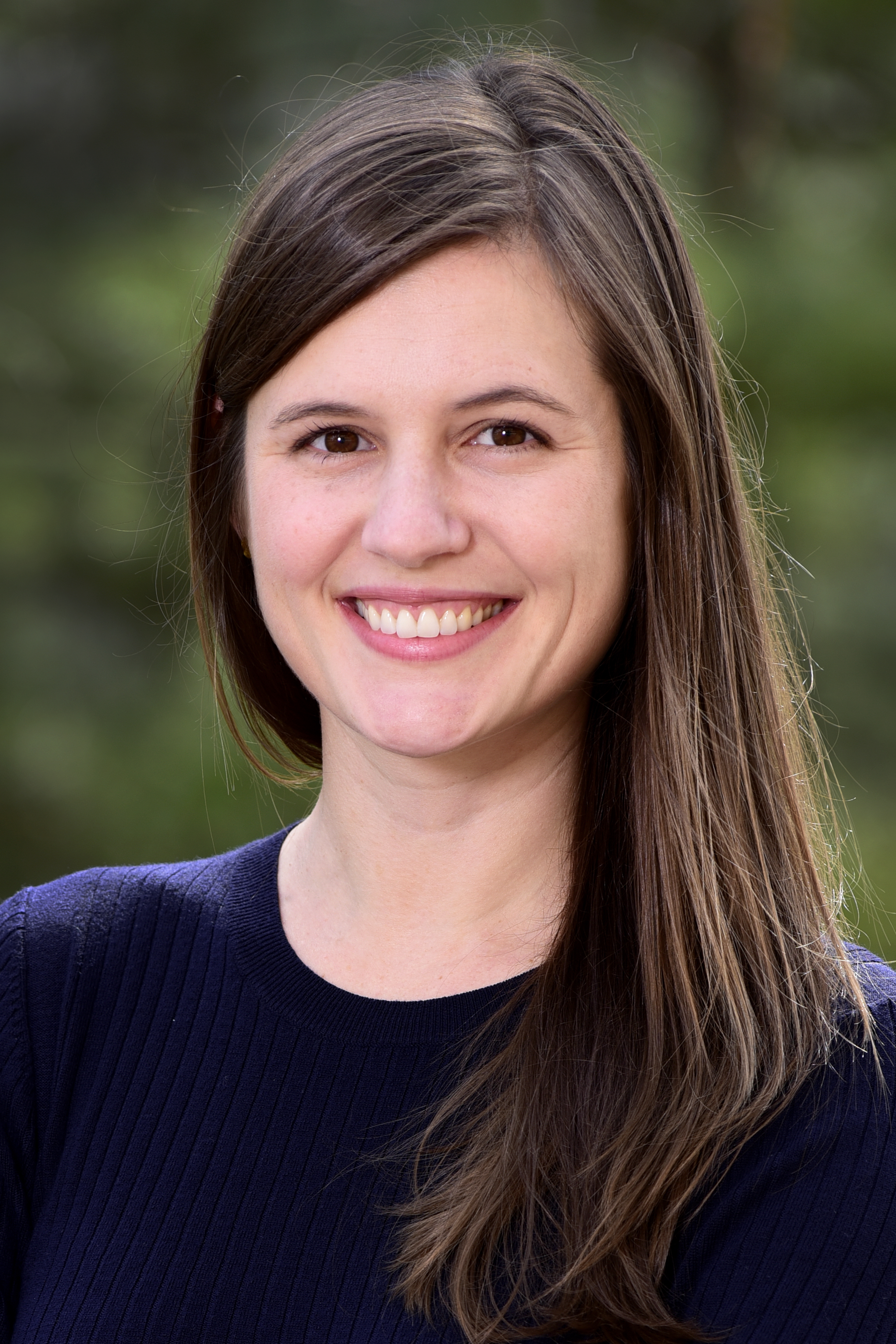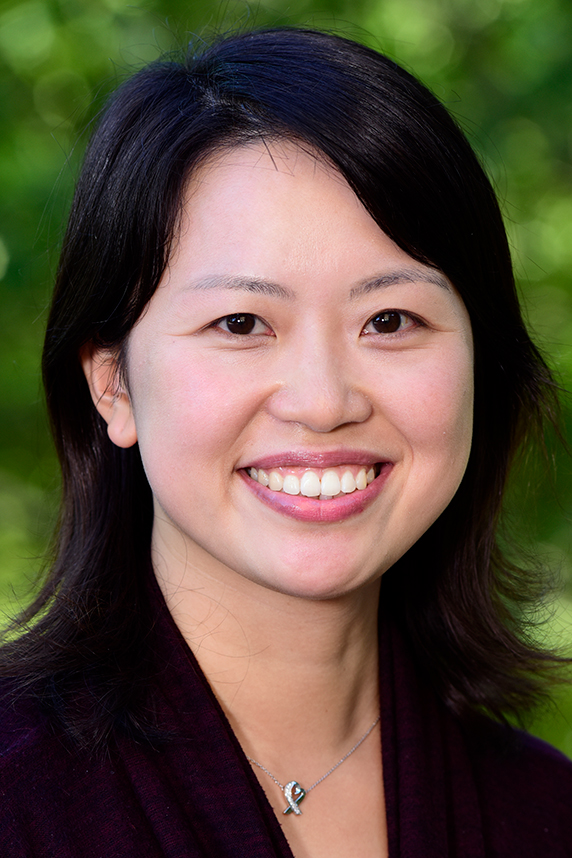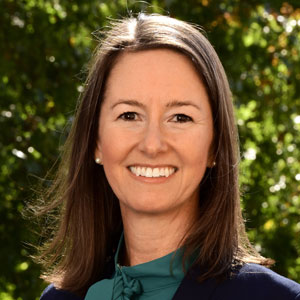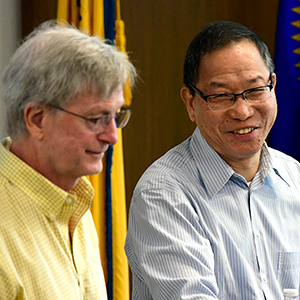Kelly Ferguson, Ph.D., Chandra Jackson, Ph.D., and Shanshan Zhao, Ph.D., have been granted tenure. We celebrate their achievement and recognize their scholarly work by highlighting them in the profiles below. Learn more about their journeys to NIEHS, the research they conduct at the institute, and what is ahead.
Kelly Ferguson, Ph.D.

Kelly Ferguson, Ph.D., leads the Perinatal and Early Life Epidemiology Group and holds a secondary appointment in the NIEHS Reproductive and Developmental Biology Laboratory.
Education: University of Michigan (B.S. in biopsychology and cognitive science); University of Michigan School of Public Health (M.P.H. in occupational and environmental epidemiology and Ph.D. in environmental health sciences).
Training: Postdoctoral research fellow and NIEHS P30 Center scientist, Department of Environmental Health Sciences, University of Michigan School of Public Health, Ann Arbor (2014-2015).
Before coming to NIEHS: Research assistant professor, Department of Environmental Health Sciences, University of Michigan School of Public Health, Ann Arbor.
Came to NIH: In 2016 as a tenure-track investigator, Epidemiology Branch, NIEHS Division of Intramural Research.
Outside interests: Outdoor activities like biking, hiking, and swimming at home in North Carolina or back in Michigan; cooking new recipes (current focus area: pies); University of Michigan football.
Website: Kelly Ferguson, Ph.D.
Research interests: My research examines environmental chemical exposures in pregnancy and their associations with adverse pregnancy outcomes, as well as long-term health effects in the mother and child. A major focus of my research is on exposure to phthalates, which are commonly used as plasticizers and in personal care products. Since coming to NIEHS, I have been investigating the relationship between exposure to phthalates in pregnancy and preterm birth. This work culminated in my work establishing a consortium of 16 U.S. cohorts and over 6,000 pregnant participants. In this study, we found robust evidence of associations between prenatal urinary concentrations of several phthalate metabolites and preterm delivery.
Another major emphasis of my research has been on understanding how multiple chemical exposures may work together to impact health. In a multi-ethnic cohort from the Netherlands, we found that exposure to a mixture of chemicals, including phthalates, bisphenols (like BPA), and pesticides, was associated with reduced growth of the fetus in utero. These findings are important because most studies examine chemicals one at a time, ignoring their potentially cumulative impact.
Finally, my research highlights the importance of oxidative stress and inflammatory pathways as key mechanisms in the relationship between prenatal chemical exposures and adverse pregnancy outcomes. Using molecular markers of these processes, we have shown that exposure to chemicals in pregnancy is associated with inflammation, and that, at the same time, inflammation is central in the etiology of pregnancy outcomes like preterm birth and preeclampsia, as well as growth of the fetus during pregnancy.
What’s next? My long-term research goals are to better understand the contribution to adverse reproductive outcomes made by the multitude of chemical stressors in our environment. We are working to examine new classes of chemical exposures — individually and as a mixture — in order to more comprehensively capture the pregnancy exposome.
Chandra Jackson, Ph.D.

Chandra Jackson, Ph.D., is a senior investigator in the NIEHS Social and Environmental Determinants of Health Equity Group.
Education: Bethune-Cookman University (B.S. in biology); Harvard T.H. Chan School of Public Health (M.S. in cardiovascular epidemiology); Johns Hopkins University (Ph.D. in cardiovascular epidemiology).
Training: Alonzo Smythe Yerby postdoctoral fellowship, nutrition/epidemiology, Harvard T.H. Chan School of Public Health (2012-2014).
Before coming to NIEHS: Research associate, Population Health Research Program, Harvard Catalyst Clinical and Translational Science Center at Harvard Medical School, Boston (2014-2016).
Came to NIH: In 2017 as an Earl Stadtman investigator (tenure-track), NIEHS Epidemiology Branch, and as an adjunct investigator, Intramural Research Program, National Institute on Minority Health and Health Disparities.
Outside interests: I enjoy daily nature walks and bike riding; domestic and international travel; many art forms such as wood working, painting, and sculpting; and attending concerts, as well as comedy shows with friends and family.
Website: Chandra Jackson, Ph.D.
Research interests: Sleep, an essential human need for maintaining biological homeostasis, is a seemingly simple behavior and yet complex physiological state. It is not entirely endogenous and is, therefore, positively or negatively affected by modifiable physical (e.g., light; temperature; noise), as well as social (e.g., psychosocial stress) environmental factors. These factors vary by race, ethnicity, and socioeconomic status. Preventing or minimizing the impact of environmental disturbances on sleep duration, quality, and timing could help populations avoid or delay a host of chronic diseases, such as cardiovascular disease, while addressing health disparities.
My research group seeks to determine the social and biological pathways linking these upstream, modifiable physical and social environmental factors to sleep and cardiovascular health in the overall population and by race, ethnicity, and socioeconomic status.
What’s next? My research group has begun to illuminate how the science of sleep can be leveraged to help advance the agenda of addressing climate change, which is important because our society is currently burning fossil fuels to, in part, heat and cool houses for comfortable sleep. Our research on the determinants and consequences of climate change in relation to sleep health will hopefully lead to the inclusion of sleep into post-disaster messaging, sleep-related products (e.g., eye masks) into disaster kits, treatment recovery, and resource allocation to help with climate change mitigation and adaptation. Our research could also lead to the development of a plan to ensure access to sleep-related health care in the disaster context. We can also inform climate adaptation strategies (e.g., low-income home energy assistance program, home weatherization) for socially vulnerable communities.
Shanshan Zhao, Ph.D.

Shanshan Zhao, Ph.D., is a senior investigator in the Biostatistics and Computational Biology Branch and holds a secondary appointment in the Epidemiology Branch.
Education: Peking University, Beijing, China (B.S. in applied mathematics); University of Iowa, Iowa City (M.S. in biostatistics); University of Washington, Seattle (Ph.D. in biostatistics).
Training: Postdoctoral research fellow at the Fred Hutchinson Cancer Research Center, Seattle (2012-2014). Came to NIEHS: In 2015 as a tenure-track investigator.
Came to NIEHS: In 2015 as a tenure-track investigator.
Outside interests: Gardening; painting; spending time with family.
Website: Shanshan Zhao, Ph.D.
Research interests: My main research interest is to develop novel statistical methods to discover how humans’ interaction with the physical and social environments influence their health and well-being. By developing and applying powerful statistical tools, my group aims to elucidate the etiology of various health outcomes through assessing risk factors and further building robust risk prediction models.
Toward achieving this overarching goal, we use a dynamic approach by integrating statistical methodological developments and collaborative population-based studies through two aspects. First, we develop general statistical methods for disease risk assessment, with a focus on methods for time-to-event outcomes. Many biological studies follow time-to-occurrences for multiple events, such as the onset of diseases or death, which motivated us to develop joint models for multivariate time-to-event outcomes. These methods enable researchers to take a lifetime history of related health outcomes into account for accurate prediction of future diseases.
Second, we develop statistical methods for cancer and environmental epidemiological studies, motivated by our collaborations with other NIEHS researchers. An area of special interest is developing statistical methods for various issues in environmental mixtures analysis to account for the synergy and interaction between components of high dimensionality and high correlation.
What’s next? My group constantly interacts with scientists within and outside NIEHS to understand the areas of environmental research that are fast developing and require innovative statistical methods. We are currently working with complex environmental mixture data that are followed up longitudinally, which provides enriched data to look into the growth pattern, cumulative effects, and critical window of these exposures on human health. I envision bringing more statistical learning methods into my research to elucidate environmental impact on human health.
(Jennifer Harker, Ph.D., is a technical writer-editor in the NIEHS Office of Communications and Public Liaison.)









